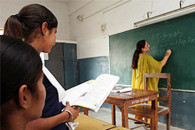Education woes: End the gap, orders SHC
Against 42,000 primary schools in Sindh, there are only 2,000 high schools, 279 colleges

PHOTO: EXPRESS
To the court’s utter dismay, Sindh’s top education officials shared that against 42,000 primary schools in the province, there are only 2,000 high schools and 279 colleges.
“For the dropout rate of around 80% after primary education, this huge difference between the existing primary and high schools seems to be the major reason,” observed Justice Salahuddin Panhwar on Wednesday during the hearing of five identical petitions regarding education at the Hyderabad circuit bench.
“Why is it not possible to open a high school in each union council? Why is there only the policy of primary schools in a UC?” he questioned the Sindh school education secretary Fazlullah Pechuho, who was present at the hearing along with Sindh secretary for college education, Dr Riaz Ahmed Memon.
“Lots of upgradation schemes are underway,” replied Pechuho. However, he could cite with accurate numbers only the $81-million United States Agency for International Development (Usaid)-funded project for upgrading 106 primary schools to high schools and another similar project of Japan International Cooperation Agency (Jica) for 53 schools.
“If there are 42,000 government primary schools in Sindh, what should be the number of the government middle and high schools?” Justice Panhwar asked Pechuho, terming the situation ‘alarming’.
But the question elicited an ambiguous answer. “I don’t have a medicine for a quick fix,” retorted Pechuho. To this, the judge replied, “There is no question of medicine but responsibility ought to be fixed on the delinquent officers.”
The schools secretary said that the government has so far set up high schools at taluka level in most of the districts. However, he was prompted to reveal that out of 131 talukas in 29 districts of Sindh, the government is yet to open girls’ high schools in 29 talukas. “A majority of the high schools [in Sindh] is for the boys,” Pechuho told the court.
“Those [girls] who need to be taught have no schools for them. Girls are mothers of tomorrow who will teach the new generation,” observed Justice Panhwar.
The colleges secretary informed the court that for around 400,000 students, there are 279 colleges in Sindh. But, he added, 132 of them are in Karachi alone while the remaining 147 colleges are located in the rest of Sindh. He failed to answer when asked by the court to provide statistics about the number of private colleges and enrolment.
The two secretaries appeared at loggerheads on the matter of higher secondary schools that provide college education while using the buildings and staff of high schools.
“This faulty policy is creating havoc in the education department. A high school shall provide education only till class 10,” contended Pechuho, who again failed to share the number of such schools in the province upon the bench’s query.
Meanwhile, Memon maintained that the purpose of the higher secondary schools is basically to cut the operational cost of running a college. “We use a building of a high school and appoint the subject teachers for classes 11 and 12.”
Taking up his plea for not passing an order against the separation, the bench asked the chief secretary of Sindh to resolve the controversy and submit a report in the court.
The court also ordered the government to establish two colleges in Khipro taluka of Sanghar and Pithoro taluka of Umerkot district from the CM’s special non-annual development plan’s funds. The bench further ordered that a boys’ college and a girls’ college, equipped with information technology labs, should be established in each of 29 talukas of Sindh, which continue to lack the government colleges.
The schools secretary informed the court that he has sent names to the chief minister for selection of a head of the Sindh Curriculum Council’s curriculum wing. The six names recommended for the position include Nisar Ahmed Siddiqui, Sadiqa Salahuddin and Mazharul Haq Siddiqui.
On the matter of journalists working as teachers and employees in the government departments, the SHC ordered that a divisional commissioner-led three-member committee should probe the matter, take action and submit a report in two months.
Published in The Express Tribune, December 16th, 2016.



















COMMENTS
Comments are moderated and generally will be posted if they are on-topic and not abusive.
For more information, please see our Comments FAQ